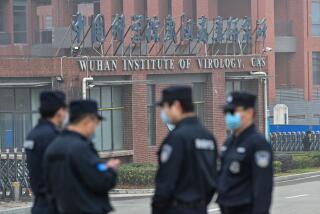AIDS-Like Cases Called No Cause for Alarm : Medicine: Experts meeting in Amsterdam predict that researchers will quickly unravel the mystery of a possible new virus.
- Share via
AMSTERDAM — Experts gathered at the eighth International Conference on AIDS insisted Thursday that there is no reason for undue alarm over reports of a possible new virus that may be linked to a baffling series of AIDS-like cases, and they predicted that researchers will unravel the mystery quickly.
To that end, World Health Organization officials announced that they plan to hold a meeting soon to determine the extent of the cases. U.S. experts said they will step up their investigations of the phenomenon.
“This problem will be very actively pursued by the scientific community,” said Dr. Anthony Fauci, director of AIDS research for the National Institutes of Health. “If there is something, they will find it. You don’t want to be complacent--but there is no reason to panic right now.”
For the last three days, leading AIDS researchers attending the conference have spoken of little else but the two dozen or so puzzling cases in which patients have developed an AIDS-like illness but show no evidence of infection with either of the two known human immunodeficiency viruses that cause AIDS. On Wednesday, UC Irvine scientists reported in California that they have found evidence of a previously unknown virus in the blood of nine such people.
Several patients discussed at the conference had known risk factors for acquired immune deficiency syndrome. They included gay men and blood transfusion recipients. But there has been no sign of clustering of cases by partners or geography, as there was at the start of the AIDS epidemic in 1981. Such a common denominator could indicate evidence of transmission.
“This is preliminary information that needs to be confirmed,” said Dr. James Curran of the U.S. Centers for Disease Control, whose agency found six such cases. “We all take this . . . very seriously. We don’t know the magnitude of the problem at this time, but it pales in comparison to AIDS.”
“We need to launch a worldwide follow-up,” said Dr. Michael Merson, head of the global program on AIDS for the World Health Organization, in announcing plans for a meeting on the subject. “WHO will bring together experts who will analyze all the information available and see what needs to be done to get to the bottom of this.”
At a special session called Thursday in response to the UC Irvine report, many AIDS experts expressed reservations about the scientific paper released Wednesday by UC Irvine immunologist Dr. Sudhir Gupta. In the report, he described finding particles from a virus--which he has dubbed human intracisternal retrovirus--that he said are likely evidence of a previously unknown class of viruses called retroviruses.
Gupta discovered evidence of the virus in a 66-year-old Southern California woman with a type of pneumonia common to AIDS patients but who tested negative for HIV, which is also a retrovirus. He later found signs of the virus in the blood of eight other HIV-negative patients with standard AIDS symptoms. He also found the virus in the woman’s daughter, who had no such symptoms.
Several AIDS experts here said the discovery of viral particles does not prove the existence of a new retrovirus, or that it causes disease.
“I’m not at all convinced Dr. Gupta has found a new retrovirus,” said Dr. Myron Essex of the Harvard AIDS Institute. “I would place the odds at less than 5%.”
Essex said he bases his skepticism on the fact that intracisternal particles in humans are not new, and “in no case in humans have they been clearly linked to disease. I’m not yet convinced we should consider them a virus.”
Dr. June Osborn, a virologist who heads the National Commission on AIDS, speculated that the organism could be one “that has always been around” but was discovered only recently because of the increased level of surveillance that has resulted from the AIDS epidemic. “It’s possible this is something that has always been with us, but not causing trouble, (and) we weren’t looking for it before,” she said.
But they agreed that Gupta’s findings--and those by other researchers working on the same problem--are compelling enough to warrant a vigorous scientific investigation.
Dr. David Ho, director of the Aaron Diamond AIDS Research Center at New York University, has been studying 11 patients with an AIDS-like disease in Los Angeles and New York who have tested negative for HIV-1 and HIV-2. Ho said he has also found evidence of a retrovirus in four cases that is definitely not HIV-1 or HIV-2.
The most immediate public problem posed by the possibility of a new AIDS-like virus would be in blood-screening programs and in diagnostic testing of those seeking to find out if they are infected.
Experts said the public should always maintain a certain level of concern about blood transfusions because the blood supply has never been totally free of all disease-causing organisms. “But there is nothing here that should be adding anxiety to that legitimate level of concern,” Osborn said.






